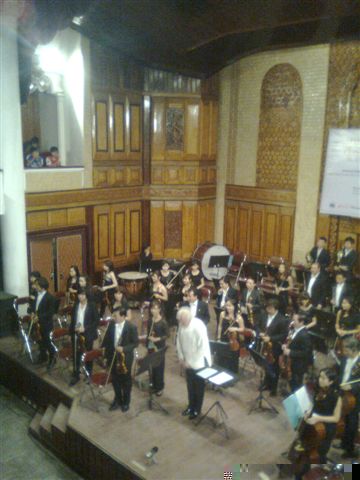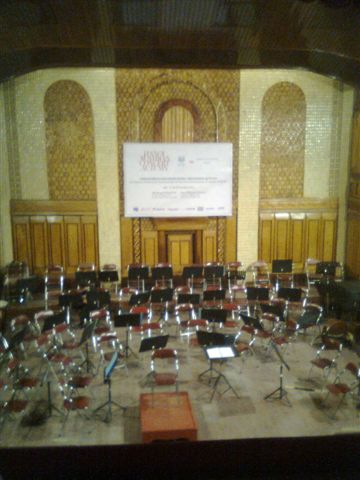KVT – Rococo Meets Art Deco


I don’t mind attending recitals and concerts at the National Academy of Music. Their Concert Hall is a delightful version of fading Art Deco and its feature wall is almost a masterpiece and should be maintained…and if a new academy is ever built, that wall should be preserved. Its always a pity that a large section of the feature is always covered by promotional banners during performances as, in full view, though damaged, it’s pretty nice.
The Austrian Embassy with related Austrian enterprises gave us a free, two-night season with Austrian conductor Wolgang Groehs in charge of the Hanoi Philharmonic Orchestra, stirring some really good notes off the honey-colored wall. Unlike a lot of newer theaters, the acoustics are good, perhaps because it’s nice and intimate.
They got us bouncing and alert with Rossini’s overture from ‘The Italian Girl in Algeria’, last used to get the audience motivated last June at Nha Hat Lon by the VNSO. This led us into the night’s feature performance, Tchaikovsky’s ‘Rococo Variations’ with 20-year-old Dutch-born and Austrian-educated cellist Harriet Krijgh soloing on the Cello for the 20-minute length of this lovely work.
The cello is sometimes described as being made for lost love, and that its mournful melancholic aspect enchants the romantic in everyone. This applies to me too, but I’ve been in love with the glorious instrument ever since I heard Jacqueline Du Pre on a vinyl recording when I was a callow adolescent. Thus I’m always drawn to performances by good players…and Krijgh is certainly much more than just good.

Its magic began when the the flutes lifted you up, the strings pitzacattoed, the horn played its mellow notes and Krijgh launched into the melody that draws us fulsomely into the first of the seven variations that make up the work. You know that this melody is going to be hard to get out of your head.
You already became totally hooked by Harriet’s playing in the second when the cello dances that tune around and then slowly takes you by the hand into the third where (as I once heard it put) we get the big tune….as romantic as a candlelit dinner for two. It gets almost unbearably beautiful and at the end the strings softly grasp it, pass it to the woodwinds and cello and gradually it sighs way up into cloudless skies.
If anything, the fourth is almost bucolic with the cello singing to us, often as high as clouds until a flute, pure and true, like a hovering songbird takes us into the fifth. And it’s here that Harriet showed her real prowess as the cello showed us its passion, sometimes an all too intense sadness and longing,
In the sixth variation the cello hauntingly and plaintively plays that lovely tune – that we are all now almost swaying with, and a clarinet mediates – until, as the strings and woodwinds ebb away, the cello takes hold and leads you quietly up and up to dreamy heights. Then, almost too rudely, the strings thunder us into a racing, bracing finale, where any lingering sadness or despair is dispelled in the cello’s trills and spills, that leaves us all a trifle breathless, but more than replete.
Couldn’t have asked for better on a balmy evening. If she can play this beautifully at such a young age, then imagine the heights she is going to scale! Mind you she’s already stood on a few peaks.
Below are two video clips of cellist Soo Bae playing the Variations with the Asian Youth Orchestra. It’s a nice interpretation too but I’ve used it because it indicates where each variation begins.
Part1:
[youtube]http://www.youtube.com/watch?v=1d0okmsJuMY[/youtube]
Part 2:
[youtube]http://www.youtube.com/watch?v=X8rIso62SNI&feature=related[/youtube]
Because Tchaikovsky took his rococo theme from the work of Mozart – who was the darling of the musical firmament when rococo was all the decadent rage in art and design – it was fitting that the Symphony that filled the space after interval was Mozart’s ‘Jupiter’.
Woody Allen is supposed to have said that the Jupiter proves the existense of God and conductor Groehs was out to make sure that The Philharmonic made us realize that that was a truth.
Gorehs held the players on a tight rein and they gave us a performance that admirably met the challenge that Mozart set for players in his last symphony when his reputation was on the down slope and he wanted to recapture the public’s imagination…and some much-needed money.
They were fired up in the first movement, lost ground ever so slightly in that lovely second movement and got their waltz, or rather minuet, into great swing in the third.
It’s the finale by which an orchestra is judged in the Jupiter. Here Mozart uses five different melodies simultaneously and concludes in a great blaze of trumpets and drums. This certainly made us all feel that we’d finished our evening in grand form.
The Hanoi Philharmonic seems to be on a real high every time I visit them and are delightful to watch and listen to under someone as obviously amenable as Groehs.
An admirable Austrian evening.
![]()
| Kiem Van Tim is a keen observer of life in general and the Hanoi cultural scene in particular and offers some of these observations to the Grapevine. KVT insists that these observations and opinion pieces are not critical reviews. Please see our Comment Guidelines / Moderation Policy and add your thoughts in the comment field below. |













